
437
.pdf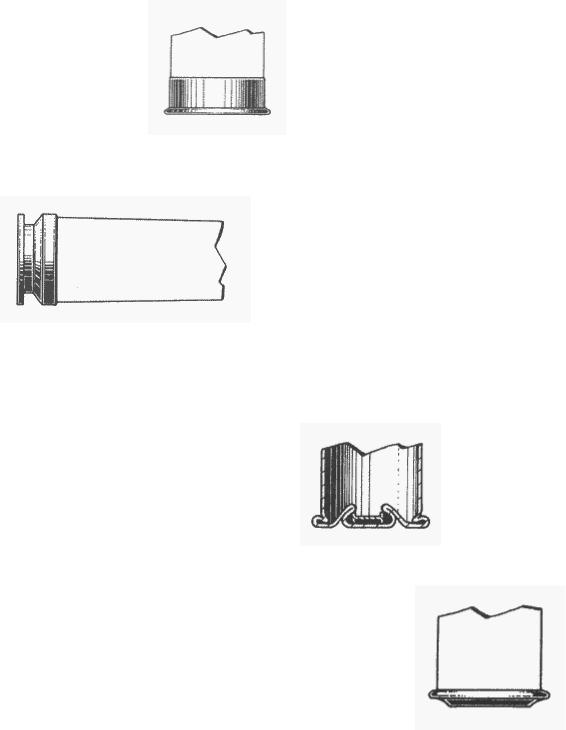
LOW BRASS - Shotshells whose brass head extends only 1/4 inch or less up the
case from the base.
MAGNUM - A family of high-powered or high-velocity cartridges which often have larger cases than usual for their caliber. They often use a belted case.
MARTIN PRIMER - A patented U.S. inside-primed cartridge (patents #88,191, 3-23-1869; #111,856,2-14-1871) with a relatively complex folded case design. Its principal identifying feature is a large, circular primer-like disc in its head. Mostly found in copper-cased.50-70 cartridges, .44,.45 and .50 caliber pistol cartridges.
Rarely found in brass, or other calibers.
MAUSER "A-BASE" - A case whose base has a raised central portion; an early
Euro-pean design. Often found with raised headstamps
MEIGS CARTRIDGE - A series of unique and mostly experimental cartridges by J.V. Meigs (patents #87,352, 4-021869; #175,293, 3-28-1876). They took a wide variety of forms and are Sometimes found in partial stages of completion. Those few types which were produced in quantity were probably made by the U.S.
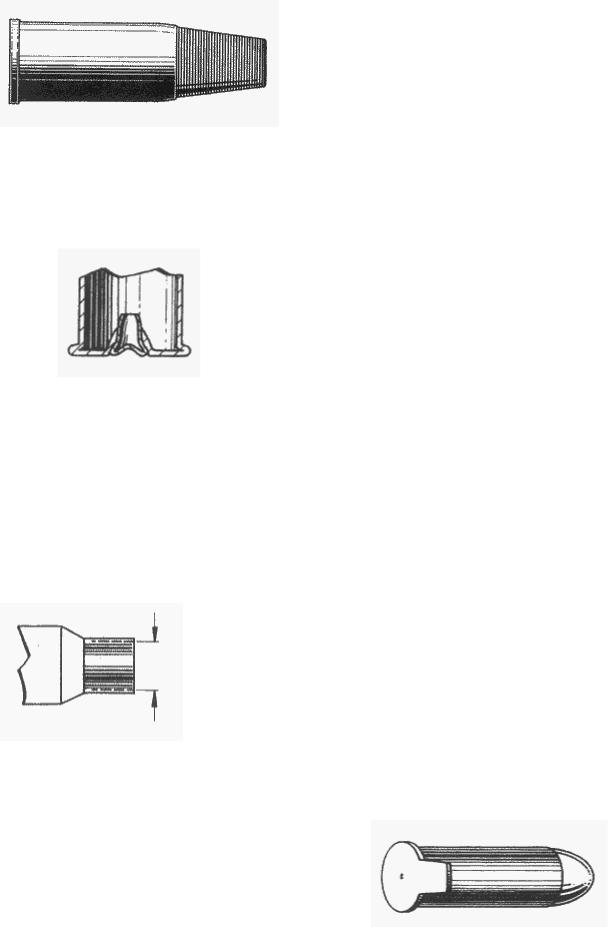
Cartridge Company. The most common is for a.50-cali-ber magazine rifle.
MILBANK-PRIMED CARTRIDGE - A scarce centerfire cartridge primed with a unique-appearing primer - one which looks like a struck primer. It functions like a rimfire cartridge. These were the subject of one of thirteen cartridge patents awarded to Isaac Milbank. Found in a variety of calibers, most commonly in .58 Musket, .42 Russian, .43 Spanish and .45-75. Rarely in a few other calibers such as
.50-70.
MORSE CARTRIDGE - Early self-contained cartridges by George Morse (patents # 15,996, 10-28-1856; #20,214, 511-1858;#20,727,6-29-1858). Considering the state-of-theart at the time, these metallic, self-contained, reloadable cartridges were remarkably far sighted. Several types were produced in a variety of calibers. The best known variety used a rubber base ring to retain a percussion-cap primer and to provide a gas seal. Much later, a type was introduced in .45-70 to facilitate reloading of cases.
MOUTH - The open end of the cartridge case into which the bullet is seated. The "mouth diameter" is the internal measurement of this feature.
MULE EAR CARTRIDGE - The projecting extractor "ear" is similar in purpose to the Maynard
"Flop Ear" case except this term is usually applied to .36-caliber cartridges for the
Sharps droppings block pistol and pistol-carbine.
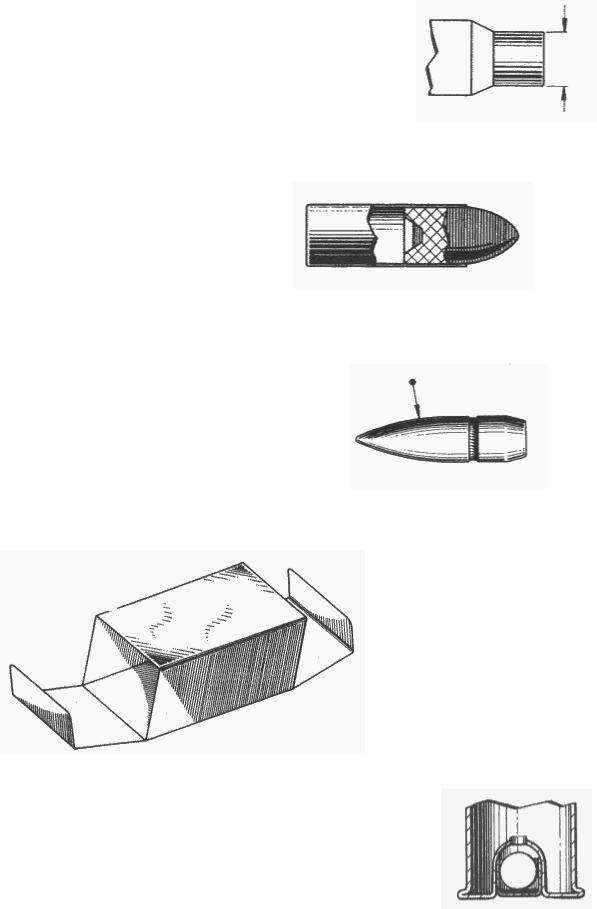
NECK - The front portion of the cartridge case into which the bullet is seated. The
"neck diameter" is the external measure of this feature.
NEEDLEFIRE - A type of cartridge designed for use in a gun whose firing pin is a long needlelike device which penetrates the base of the cartridge and impacts
upon a primer at the base of the bullet.
NICKEL-PLATED - Cartridge cases, bullets or primers which have been electroplated with nickel and which have a characteristic bright silvery appearance.
OGIVE - The curved forward part of a bullet.
ONE-PIECE BOX - Cartridge boxes formed from one piece of cardboard with flap ends Usually refers to collectible .22caliber rimfire or shotshell boxes.
ORCUTT PRIMER - A patented type of primer used for a short time by UMC.
They are unusually long and require a deep primer pocket.
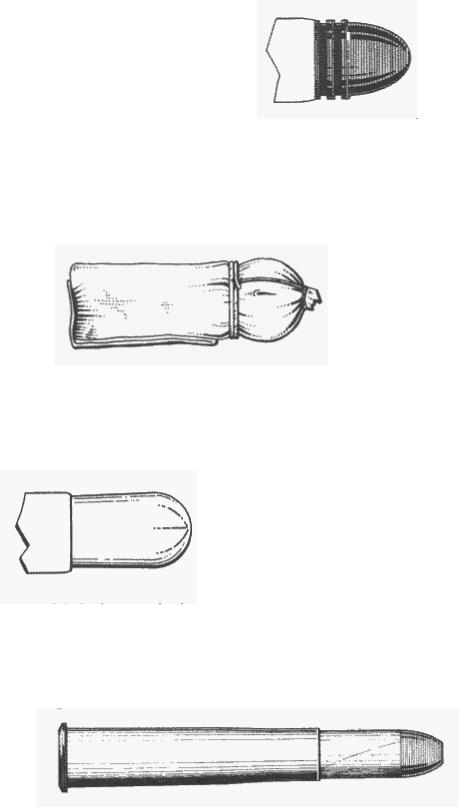
OUTSIDE-LUBRICATED BULLET- Bullets with exposed annular grease
grooves, or other applied lubricants, often heel-type.
PAPER CARTRIDGE - An early class of cartridge usually consisting of a bullet and measured powder charge wrapped in a tubular paper envelope. In use, the container was torn open, the powder poured down the muzzle of the weapon and the paper used as a wad or discarded. Other types, using treated paper envelopes, are sometimes termed "paper cartridges" but these are more properly classified as
"combustible cartridges."
PAPER-CASED SHOT CARTRIDGES –
1.Metallic cartridges which have a paper-encased shot load instead of the metallic projectile.
2.Shotshells where the major material of the case is paper, usually with a brass,
steel or zinc head.
PAPER-PATCHED BULLET - Bullets which have their bearing surface and base wrapped with paper. The paper is intended to engage the bore's rifling and strip off as the bullet exits. The purpose is to minimize distortion of the bullet and reduce wear on the bore. Most often used with target rifles and European military
rifles in the late 1800s.
PATENT IGNITION - Any cartridge with an unusual patented ignition system. Usually refers to early, developmental types. Common primer types such as Berdan or Boxer, although patented, are not included in this category. See, for example, Martin, Benet, Morse, etc.
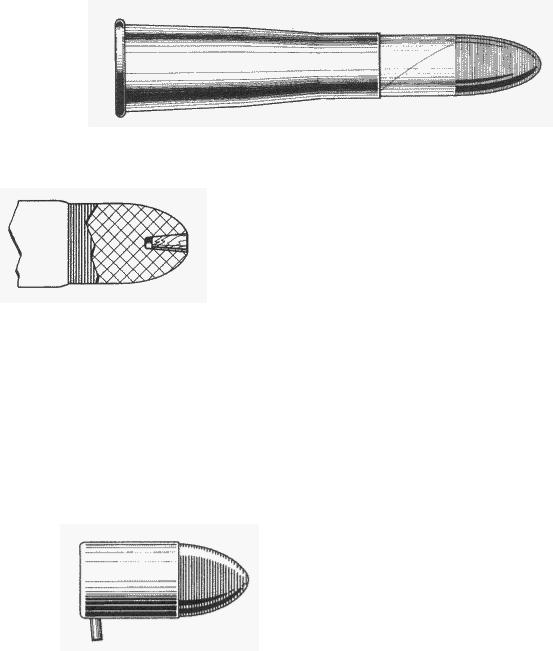
PEABODY CARTRIDGE - A family of cartridges designed for use in guns of the Peabody-Martini design. Peabody cartridges include the distinctive "What Cheer" series and a variety of rare rimfires as well as some more common
centerfires.
PEGGED BULLET - Usually a lead, hollow-point bullet into which a wooden peg has been inserted to assist expansion or preserve the shape of the cavity.
PERCUSSION CARTRIDGE - Although most cartridges are technically percussion cartridges since detonation is a result of a percussive blow to the primer, percussion cartridges are usually thought of as separate-primed cartridges used in early breechloading guns where ignition is the result of use of a percussion cap on a nipple which is a part of the gun.
PINFIRE - A cartridge having a protruding pin, usually at right angles to the base of the cartridge and projecting through the side of the case. Impact of the ham-mer on this pin causes internal ignition. Mostly made by European firms except for a few made by E. Allen, UMC and C.D. Leet. See also Horizontal Pinfire and Inside
Pinfire.
PRIMER - The ignition component of a cartridge.
PRIMER ANNULUS - The circular joint around the primers. Colored lacquer is sometimes introduced into this area to provide a visual seal and often to indicate type of loading.

REDUCED (or "REBATED") RIM - A centerfire cartridge case whose rim diameter is smaller than the diameter of the body of the case.
RIMFIRE - A major class of metal-cased cartridges which have the priming compound distributed in a ring, usually at the base of the case. The firing pin
crushes the rim, igniting the primer.
RIMLESS CARTRIDGE - Cartridges with extractor grooves, whose rims are approximately the same diameter as the rest of the head. In a very few cases, true rimless cartridges such as certain of the Bergmann series, have no extractor groove
whatsoever.
RIMMED CARTRIDGE - Cartridges with rims which are larger in diameter than
the rest of the head.
ROLL CRIMP - A type of crimp whereby the entire mouth end of the case is turned in to secure the bullet in place. This is the standard method used for many modern cartridges.
SABOT - A lightweight carrier in which a sub-caliber projectile(s) is centered to permit firing. An enclosure to facilitate the firing of shot usually in a rifled barrel.
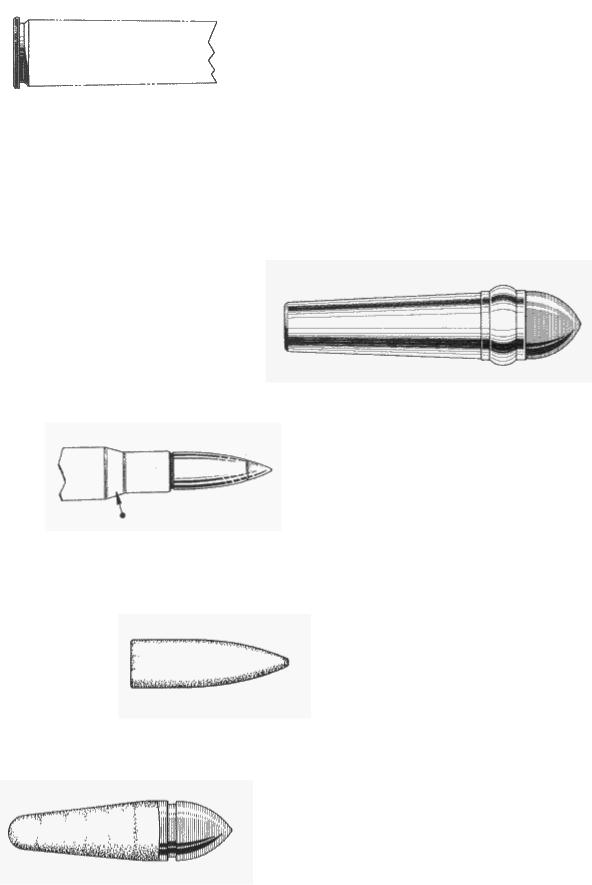
SEMI-RIMMED (OR SEMI-RIMLESS CARTRIDGE) - Cartridges with extractor grooves whose rims are larger in diameter than the rest of the head.
SEMI-SMOKELESS GUNPOWDER - A transitional relatively low-pressure propellant which bridged the gap between black and smokeless powder. "LESMOK" was a typical brand name.
SEPARATE-PRIMED - Early cartridges where only the bullet and propellant were contained within the cartridge case. The priming system was typically a percussion cap on a nipple with the flame conducted to the base of the cartridge by
internal channeling within the gun.
SHOULDER - That part of a bottlenecked case which connects the body and the
neck.
SINTERED BULLET - A solid bullet formed by the high-pressure consolidation of powdered metal into a bullet form. Such bullets were made experimentally and loaded into .30-06 cases just prior to WWII also adopted by Germany in 9mm
during the war.
SKIN CARTRIDGE - A combustible cartridge whose case was formed by nitrating natural animal gut or a substitute material.
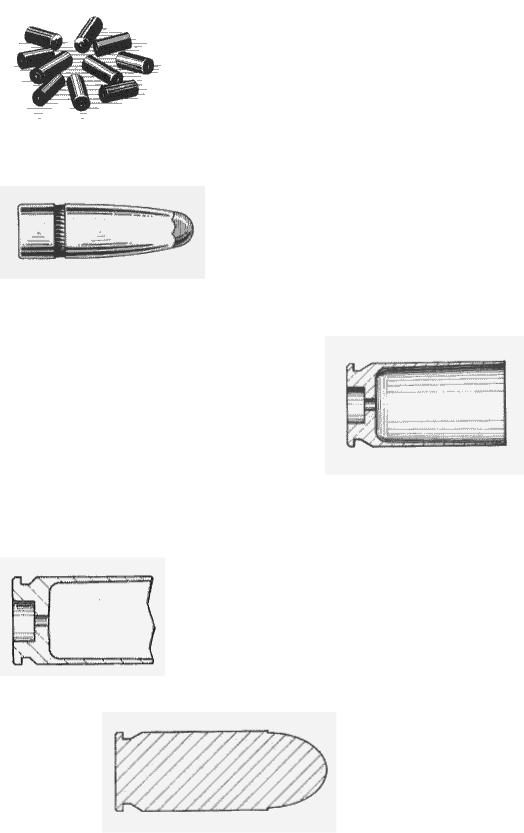
SMOKELESS POWDER - Any of a vast variety of modern nitrocellulose, or other composition, high-pressure propellants used in cartridges.
SOFT-NOSED BULLET – A jacketed bullet with exposed lead tip, usually intended for hunting, whose purpose was to expand upon impact with flesh.
SOLID-DRAWN CASE - A cartridge case formed from a metallic disc which has been subjected to an alternating series of progressive draws and anneals, resulting
in a finished cartridge case. (see Draw Set)
SOLID HEAD - The modern type of case construction where the head is formed from comparatively thick metal for reinforcement, to withstand the higher pressures of modern loads. Nearly all modern cartridges are made in this manner.
SOLID DUMMY - A dummy or exercise cartridge of solid turned or cast
construction.
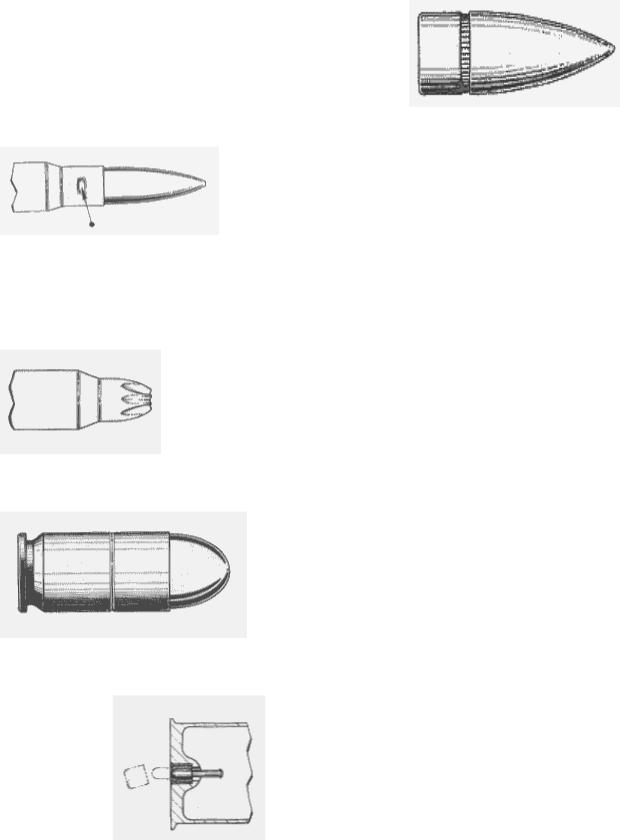
SPITZER BULLET - A pointed bullet; from the German word "'Spitz" meaning
pointed. Most modern military bullets are of this type.
STAKE CRIMP - A rectangular crimp on the case neck or primer pocket.
STAB CRIMP - A crimp on the case neck which appears as a point or dot. Also called "Point Crimp".
STAR CRIMP - A crimp used for blank or shot cartridges whereby the mouth of the case is closed by starlike folds. Also called "Rose Crimp".
STRAIGHT CASE - A cartridge case having little or no taper along its length and no abrupt change in diameter as would a "Bottlenecked" case.
STURTEVANT PATENT - A type of shotshell (patent #54,038, 4-17-1866) having a combination depriming pin and anvil built into the primer pocket, serving
dual purposes.
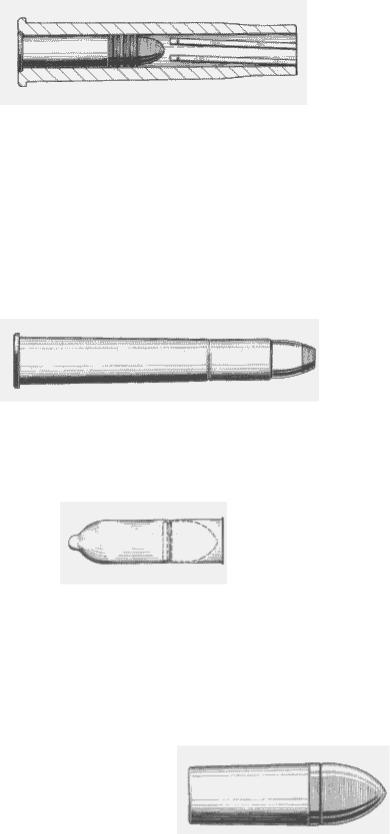
SUB-CALIBER CARTRIDGE or CHAMBER - A hollow device of cartridge dimensions, often rifled , to enable the use of a smaller caliber bullet
SWAGE CRIMP - A type of crimp whereby the entire mouth end of the case is reduced in diameter by a swaging die to secure the bullet in place. Swage crimping is the standard method of manufacturing many modern cartridges.
TAPER BORE - A experimental design of gun whereby the bore tapers to smaller diameter at the muzzle end. The objective is to create higher velocities (see Gerlich).
TAPERED CASE - Cartridges with cases tapered in diameter from base to mouth or base to shoulder. The purpose is to assist extraction.
TEATFIRE CARTRIDGE - Cartridges designed for use in front-loading revolvers (Williamson Patent #41,183, 1-051864) as a circumvention of the Rollin White patent owned by Smith and Wesson. They are characterized by a small round or flat teat in the base containing the fulminate and are known in.32 and.45
caliber.
TEFLON-COATED - Refers to cartridge cases or bullets which have been coated with Teflon to reduce friction.
THUER'S CARTRIDGE - An early type of centerfire cartridge designed for use in Thuer Conversions of the Colt percussion revolvers. They taper from the mouth to a smaller base and were front-loaded into the cylinders. They are found in .3 1,
.3 6 and .44 caliber and an extremely rare version is known in inside-primed
(Benetlike) .44 caliber.
